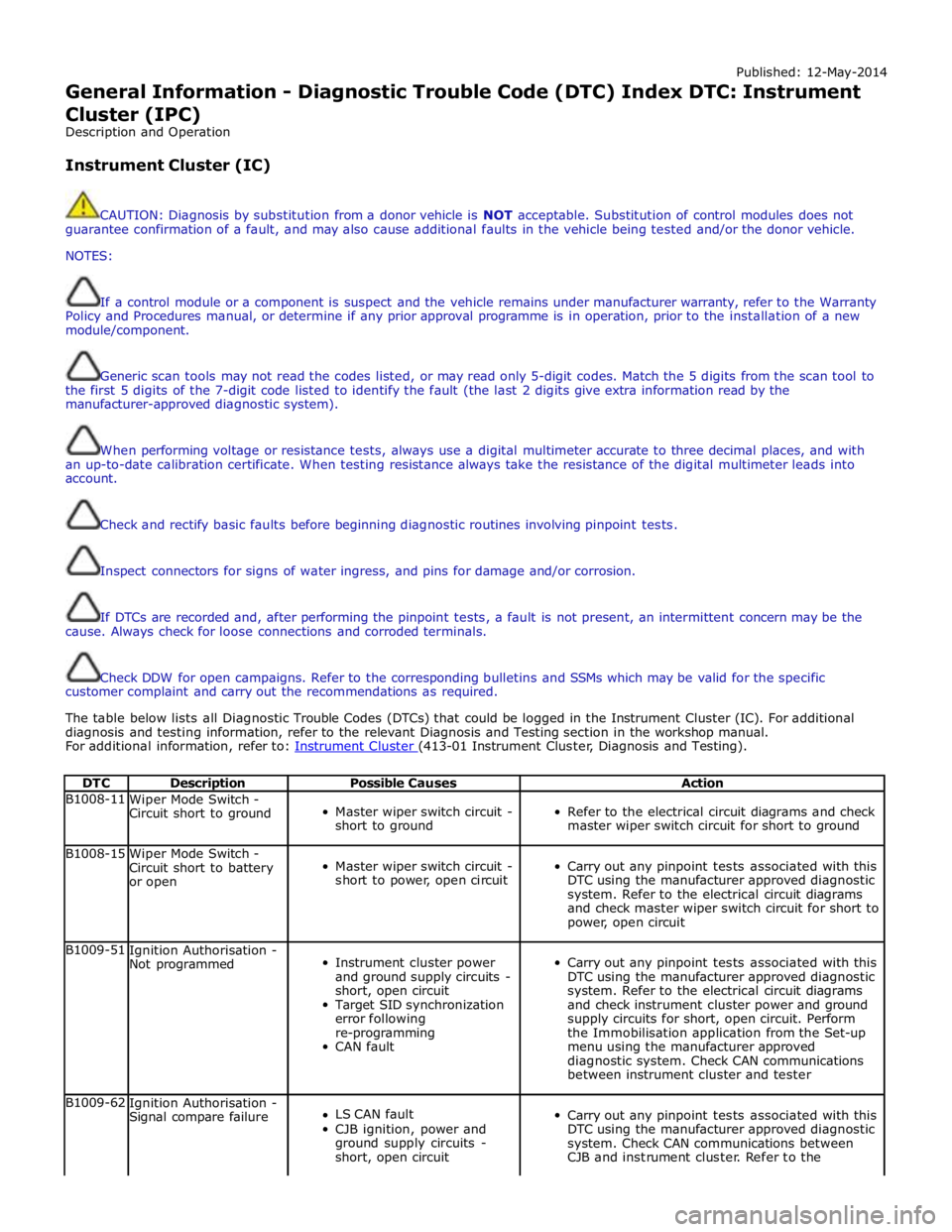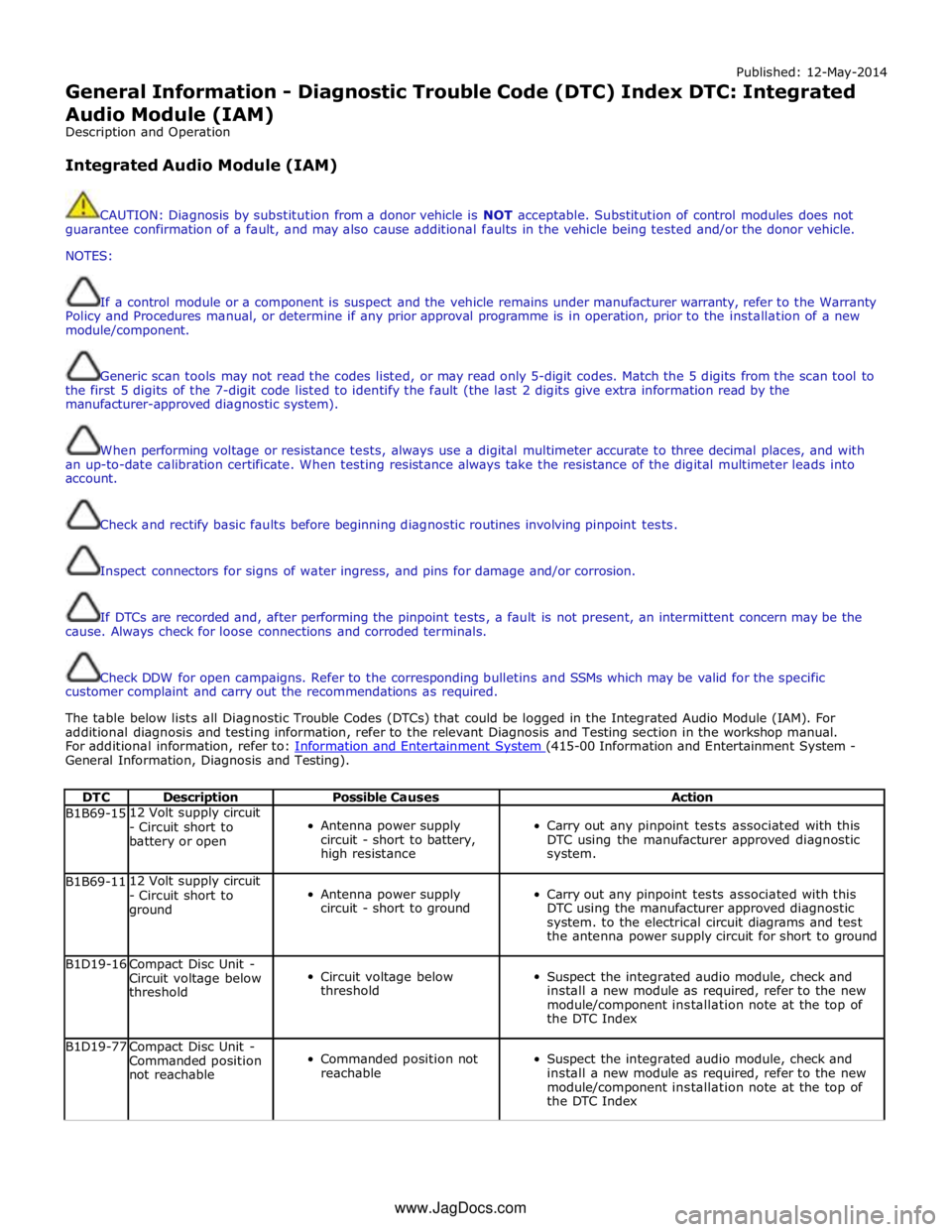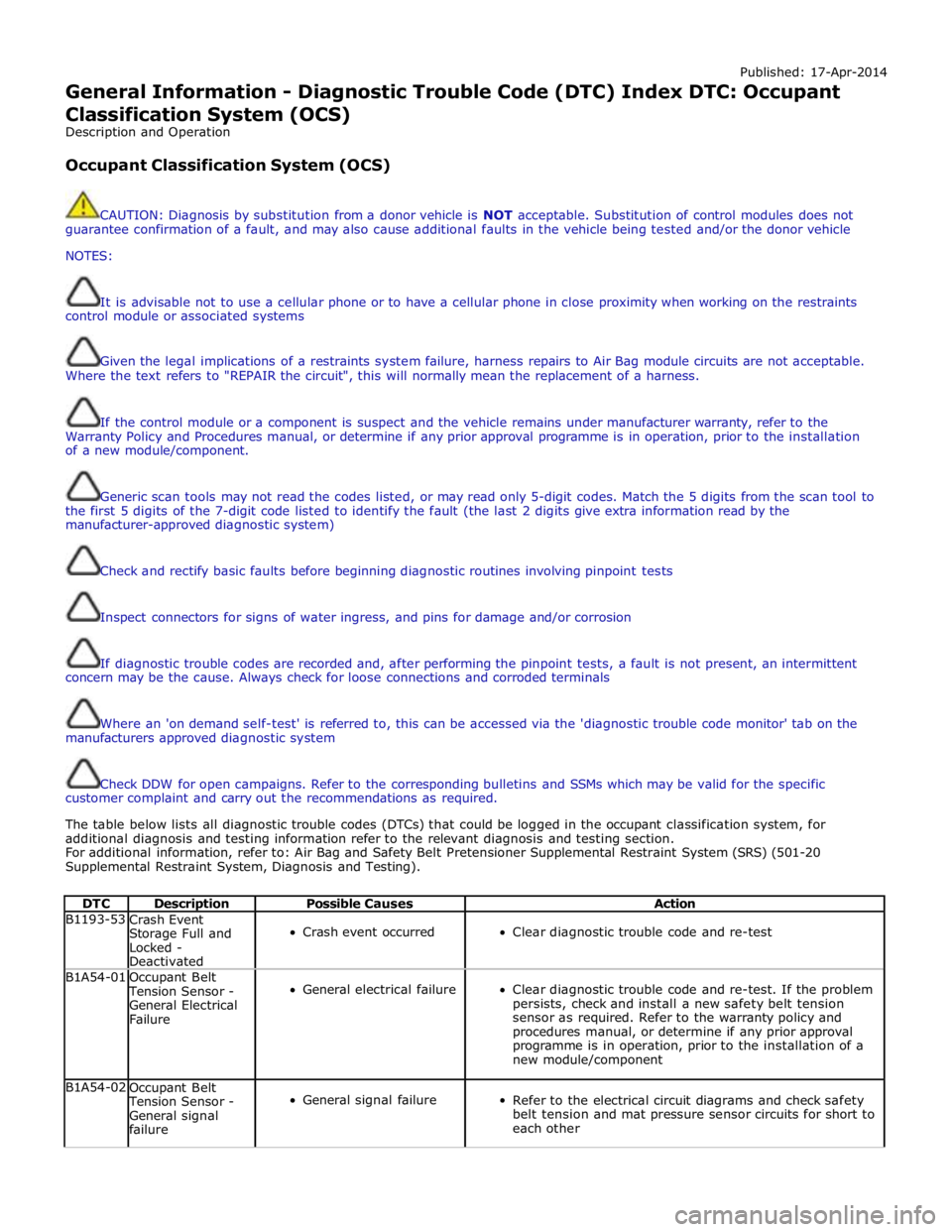Control module JAGUAR XFR 2010 1.G Manual Online
[x] Cancel search | Manufacturer: JAGUAR, Model Year: 2010, Model line: XFR, Model: JAGUAR XFR 2010 1.GPages: 3039, PDF Size: 58.49 MB
Page 186 of 3039

DTC Description Possible Causes Action U3003-62
Battery Voltage -
Signal compare
failure
Difference in battery
voltage, of 2 volts or
more, between the
central broadcast
voltage (via CAN Bus)
and Headlamp
Leveling Module
Check other modules for related stored DTCs. Refer to the
electrical circuit diagrams and check power and ground
voltages at the Headlamp Leveling Module U0428-00
Invalid Data
Received From
Steering Angle
Sensor Module - No
sub type
information
NOTE: Steering Angle
Sensor not calibrated
Invalid Data Received
from the Steering
Angle Sensor Module
Check the Steering Angle Sensor Module for stored DTCs.
Using the manufacturer approved diagnostic system,
complete the CAN Network Integrity test. Refer to the
electrical circuit diagrams and check the CAN network
between the Headlamp Leveling Module and the
Transmission Control Module U0402-00
Invalid Data
Received From
Transmission
Control Module - No
sub type
information
Invalid Data Received
from the
Transmission Control
Module
Transmission
component fault
Check the Transmission Control Module for stored DTCs.
Using the manufacturer approved diagnostic system,
complete the CAN Network Integrity test. Refer to the
electrical circuit diagrams and check the CAN network
between the Headlamp Leveling Module and the
Transmission Control Module U0126-00
Lost Communication
With Steering Angle
Sensor Module - No
sub type
information
Lost communication
with the Steering
Angle Sensor Module
CAN network fault
Check the Steering Angle Sensor Module for stored DTCs.
Using the manufacturer approved diagnostic system,
complete the CAN Network Integrity test. Refer to the
electrical circuit diagrams and check the CAN network
between the Headlamp Leveling Module and the Steering
Angle Sensor U0142-00 Lost Communication
Lost communication
Check the Auxiliary Junction Box for stored DTCs. Using the With Body Control Module "B" - No sub with the Auxiliary manufacturer approved diagnostic system, complete the type information Junction Box CAN Network Integrity test. Refer to the electrical circuit CAN network fault diagrams and check the CAN network between the Headlamp Leveling Module and the Auxiliary Junction Box www.JagDocs.com
Page 187 of 3039

Published: 12-May-2014
General Information - Diagnostic Trouble Code (DTC) Index DTC: Instrument Cluster (IPC)
Description and Operation
Instrument Cluster (IC)
CAUTION: Diagnosis by substitution from a donor vehicle is NOT acceptable. Substitution of control modules does not
guarantee confirmation of a fault, and may also cause additional faults in the vehicle being tested and/or the donor vehicle.
NOTES:
If a control module or a component is suspect and the vehicle remains under manufacturer warranty, refer to the Warranty
Policy and Procedures manual, or determine if any prior approval programme is in operation, prior to the installation of a new
module/component.
Generic scan tools may not read the codes listed, or may read only 5-digit codes. Match the 5 digits from the scan tool to
the first 5 digits of the 7-digit code listed to identify the fault (the last 2 digits give extra information read by the
manufacturer-approved diagnostic system).
When performing voltage or resistance tests, always use a digital multimeter accurate to three decimal places, and with
an up-to-date calibration certificate. When testing resistance always take the resistance of the digital multimeter leads into
account.
Check and rectify basic faults before beginning diagnostic routines involving pinpoint tests.
Inspect connectors for signs of water ingress, and pins for damage and/or corrosion.
If DTCs are recorded and, after performing the pinpoint tests, a fault is not present, an intermittent concern may be the
cause. Always check for loose connections and corroded terminals.
Check DDW for open campaigns. Refer to the corresponding bulletins and SSMs which may be valid for the specific
customer complaint and carry out the recommendations as required.
The table below lists all Diagnostic Trouble Codes (DTCs) that could be logged in the Instrument Cluster (IC). For additional
diagnosis and testing information, refer to the relevant Diagnosis and Testing section in the workshop manual.
For additional information, refer to: Instrument Cluster (413-01 Instrument Cluster, Diagnosis and Testing).
DTC Description Possible Causes Action B1008-11
Wiper Mode Switch -
Circuit short to ground
Master wiper switch circuit -
short to ground
Refer to the electrical circuit diagrams and check
master wiper switch circuit for short to ground B1008-15
Wiper Mode Switch -
Circuit short to battery
or open
Master wiper switch circuit -
short to power, open circuit
Carry out any pinpoint tests associated with this
DTC using the manufacturer approved diagnostic
system. Refer to the electrical circuit diagrams
and check master wiper switch circuit for short to
power, open circuit B1009-51
Ignition Authorisation -
Not programmed
Instrument cluster power
and ground supply circuits -
short, open circuit
Target SID synchronization
error following
re-programming
CAN fault
Carry out any pinpoint tests associated with this
DTC using the manufacturer approved diagnostic
system. Refer to the electrical circuit diagrams
and check instrument cluster power and ground
supply circuits for short, open circuit. Perform
the Immobilisation application from the Set-up
menu using the manufacturer approved
diagnostic system. Check CAN communications
between instrument cluster and tester B1009-62
Ignition Authorisation -
Signal compare failure
LS CAN fault
CJB ignition, power and
ground supply circuits -
short, open circuit
Carry out any pinpoint tests associated with this
DTC using the manufacturer approved diagnostic
system. Check CAN communications between
CJB and instrument cluster. Refer to the
Page 189 of 3039

DTC Description Possible Causes Action B100B-87
Column Lock Ground
Authorisation - Missing
message
Instrument cluster power
and ground supply circuits -
short, open circuit
LS CAN fault
RJB power and ground
supply circuits - short, open
circuit
Carry out any pinpoint tests associated with this
DTC using the manufacturer approved diagnostic
system. Refer to the electrical circuit diagrams
and check RJB power and ground supply circuits
for short, open circuit and instrument cluster
power and ground supply circuits for short, open
circuit. Check CAN communications between RJB
and instrument cluster B100C-67
Column Lock Supply
Authorisation - Signal
incorrect after event
Instrument cluster power
and ground supply circuits -
short, open circuit
LS CAN fault
CJB power and ground
supply circuits - short, open
circuit
Vehicle speed present when
attempting to power ESCL
Engine speed present when
attempting to power ESCL
PowerMode status > 4 when
attempting to perform lock
action
Carry out any pinpoint tests associated with this
DTC using the manufacturer approved diagnostic
system. Refer to the electrical circuit diagrams
and check CJB power and ground supply circuits
for short, open circuit and instrument cluster
power and ground supply circuits for short, open
circuit. Check CAN communications between CJB
and instrument cluster. Check for invalid vehicle
speed signal from ABS/instrument cluster
gateway. Check for invalid engine speed signal
from ECM/instrument cluster gateway. Check for
invalid signal from CJB B100C-87
Column Lock Supply
Authorisation - Missing
message
Instrument cluster power
and ground supply circuits -
short, open circuit
LS CAN fault
CJB power and ground
supply circuits - short, open
circuit
Carry out any pinpoint tests associated with this
DTC using the manufacturer approved diagnostic
system. Refer to the electrical circuit diagrams
and check CJB power and ground supply circuits
for short, open circuit and instrument cluster
power and ground supply circuits for short, open
circuit. Check CAN communications between CJB
and instrument cluster B100D-62
Column Lock
Authorisation - Signal
compare failure
CAN fault
ESCL power and ground
supply circuits - short, open
circuit
Instrument cluster power
and ground supply circuits -
short, open circuit
Incorrect ESCL or instrument
cluster installed
Target SID synchronization
error following
re-programming
Noise/EMC related error
Carry out any pinpoint tests associated with this
DTC using the manufacturer approved diagnostic
system. Check CAN communication between
Electronic Steering Column Lock and instrument
cluster. Refer to the electrical circuit diagrams
and check Electronic Steering Column Lock power
and ground supply circuits for short, open circuit
and Instrument cluster power and ground supply
circuits for short, open circuit. Check correct
Electronic Steering Column Lock and instrument
cluster installed. Perform the Immobilisation
application from the Set-up menu using the
manufacturer approved diagnostic system. Check
CAN network for interference/EMC related issues B100D-64
Column Lock
Authorisation - Signal
plausibility failure
Algorithm based failure-
signal plausibility failure
CAN fault
ESCL power and ground
supply circuits - short, open
circuit
Instrument cluster power
and ground supply circuits -
short, open circuit
If the customer has not reported a non start
issue, clear the DTC and check vehicle starts
correctly. If a non start issue has been reported
run the manufacturers approved diagnostic
system Start Authorisation Application and
follow the actions required for this DTC. Carry
out any pinpoint tests associated with this DTC
using the manufacturer approved diagnostic
system. Check CAN communication between
Electronic Steering Column Lock and instrument
cluster (check transmission out speed, vehicle
speed, engine speed, gear position and
powermode signals to Electronic Steering
Column Lock). Refer to the electrical circuit
diagrams and check Electronic Steering Column
Lock power and ground supply circuits for short,
open circuit and Instrument cluster power and
ground supply circuits for short, open circuit B100D-87
Column Lock
Authorisation - Missing
message - Missing
message
Missing message
CAN fault
No response from electric
steering column lock control
module, instrument cluster,
central junction box
Clear DTC, repeatedly lock and unlock car using
the key fob and retest. Check for related DTCs
and refer to the relevant DTC index
If the fault is cleared, notify the customer that
the steering column lock may fail to unlock if the
vehicle is parked with a high steering angle or
Page 190 of 3039

DTC Description Possible Causes Action Battery voltage at electric
steering column lock control
module too low
Electric steering column lock
control module, instrument
cluster, central junction box
fault with the road wheel against a curb. If the
column lock is failing to disengage, the customer
may be able to rectify this by rotating the
steering wheel while pressing the engine start
button
If fault persists, complete a CAN network
integrity test using the manufacturers approved
diagnostic system. Alternatively, refer to the
electrical circuit diagrams and check CAN circuits
between the central junction box, the instrument
cluster and the electronic steering column lock.
Refer to the electrical circuit diagrams and check
the central junction box, the instrument cluster
and the electronic steering column lock power
and ground supply circuits for short circuit to
ground, short circuit to power, open circuit, high
resistance. Repair circuit(s) as required. Clear
DTC, perform an on demand self-test and retest
If fault persists, check that the vehicle battery
supply voltage is between 9-16 volts. Rectify as
required B100D-96
Column Lock
Authorisation -
Component internal
failure
Battery voltage at electric
steering column lock control
module too low
Torque load on steering
column
CAN fault
Electric steering column lock
control module - Internal
failure
Clear DTC, repeatedly lock and unlock car using
the key fob and retest
If fault persists, check that the vehicle battery
supply voltage is between 9-16 volts. Rectify as
required
Ensure the column lock bolt movement is not
obstructed or restricted (the parked position of
the road wheels may be exerting a turning force
through the steering column, preventing the lock
from releasing. The steering wheel may need to
be held against the force to allow the column
lock to release). Clear DTC, repeatedly lock and
unlock car using the key fob and retest
If fault persists, complete a CAN network
integrity test using the manufacturers approved
diagnostic system. Alternatively, refer to the
electrical circuit diagrams and check CAN circuits
between the central junction box, the instrument
cluster and the electronic steering column lock.
Refer to the electrical circuit diagrams and check
the central junction box, the instrument cluster
and the electronic steering column lock power
and ground supply circuits for short circuit to
ground, short circuit to power, open circuit, high
resistance. Repair circuit(s) as required. Clear
DTC, perform an on demand self-test and retest
If fault persists, check and install a new electric
steering column lock control module as required B1024-87
Start Control Unit -
Missing message
Smart card docking station
failure - slave node not
responding
Carry out any pinpoint tests associated with this
DTC using the manufacturer approved diagnostic
system. Refer to the electrical circuit diagrams
and check the smart card docking station LIN
circuit for short, open circuit. Suspect the smart
card docking station, check and install a new
docking station as required, refer to the new
module/component installation note at the top
of the DTC Index B1046-11
Front Fog Lamp Control
Switch - Circuit short to
ground
Fog lamp switch circuit -
short to ground
Refer to the electrical circuit diagrams and check
fog lamp switch circuit for short to ground B1046-15
Front Fog Lamp Control
Switch - Circuit short to
battery or open
Fog lamp switch circuit -
short to power, open circuit
Refer to the electrical circuit diagrams and check
fog lamp switch circuit for short to power, open
circuit B1048-11 Brake Fluid Level Switch
- Circuit short to ground
Brake fluid level switch
circuit - short to ground
Refer to the electrical circuit diagrams and check
brake fluid level switch circuit for short to ground
Page 195 of 3039

DTC Description Possible Causes Action B1D37-11
Wiper Switch
Connection Circuit -
Circuit short to ground
Flick wipe switch circuit -
short to ground
Refer to the electrical circuit diagrams and check
flick wipe switch circuit for short to ground B1D37-15
Wiper Switch
Connection Circuit -
Circuit short to battery
or open
Flick wipe switch circuit -
short to power, open circuit
Carry out any pinpoint tests associated with this
DTC using the manufacturer approved diagnostic
system. Refer to the electrical circuit diagrams
and check flick wipe switch circuit for short to
power, open circuit C1110-64
Power steering
Calibration Data - Signal
plausibility failure
Invalid VAPS curve loaded
Re-configure the instrument cluster as new to
download VAPS curve data P0635-11
Power Steering Control
Circuit - Circuit short to
ground
VAPS ignition supply circuit
- short to ground
Refer to the electrical circuit diagrams and check
VAPS ignition supply circuit for short to ground P0635-12
Power Steering Control
Circuit - Circuit short to
battery
VAPS ignition supply circuit
- short to power
Refer to the electrical circuit diagrams and check
VAPS ignition supply circuit for short to power P0635-13
Power Steering Control
Circuit - Circuit open
VAPS ignition supply circuit
- open circuit
Refer to the electrical circuit diagrams and check
VAPS ignition supply circuit for open circuit P0635-22
Power Steering Control
Circuit - Signal
amplitude > maximum
First valid received speed
value above threshold
Check ABS module for DTCs and refer to relevant
DTC Index P0635-44
Power Steering Control
Circuit - Data memory
failure
Data memory failure
Re-configure the instrument cluster as new to
download VAPS curve data U0001-88
High Speed CAN
Communication Bus -
Bus off
Bus Off
Carry out any pinpoint tests associated with this
DTC using the manufacturer approved diagnostic
system. Carry out CAN network integrity test
using the manufacturer approved diagnostic
system. Refer to the electrical circuit diagrams
and check HS CAN network to instrument cluster U0010-88
Medium Speed CAN
Communication Bus -
Bus off
Bus Off
Carry out any pinpoint tests associated with this
DTC using the manufacturer approved diagnostic
system. Carry out CAN network integrity test
using the manufacturer approved diagnostic
system. Refer to the electrical circuit diagrams
and check MS CAN network to instrument cluster U0100-00
Lost Communication
With ECM/PCM “A” - No
sub type information
Loss of CAN communication
with ECM
Carry out any pinpoint tests associated with this
DTC using the manufacturer approved diagnostic
system. Check ECM for DTCs and refer to the
relevant DTC Index U0101-00
Lost Communication
with TCM - No sub type
information
Loss of CAN communication
with TCM
Carry out any pinpoint tests associated with this
DTC using the manufacturer approved diagnostic
system. Check TCM for DTCs and refer to the
relevant DTC Index U0103-00
Lost Communication
With Gear Shift Module
- No sub type
information
Loss of CAN communication
with transmission shift
module
Carry out any pinpoint tests associated with this
DTC using the manufacturer approved diagnostic
system. Check transmission shift module for
DTCs and refer to the relevant DTC Index U0104-00
Lost Communication
With Cruise Control
Module - No sub type
information
Loss of CAN communication
with speed control module
Carry out any pinpoint tests associated with this
DTC using the manufacturer approved diagnostic
system. Check speed control module for DTCs
and refer to the relevant DTC Index U0121-00
Lost Communication
With Anti-Lock Brake
System (ABS) Control
Module - No sub type
information
Loss of CAN communication
with ABS module
Carry out any pinpoint tests associated with this
DTC using the manufacturer approved diagnostic
system. Check ABS module for DTCs and refer to
the relevant DTC Index
Page 196 of 3039

Published: 12-May-2014
General Information - Diagnostic Trouble Code (DTC) Index DTC: Integrated
Audio Module (IAM)
Description and Operation
Integrated Audio Module (IAM)
CAUTION: Diagnosis by substitution from a donor vehicle is NOT acceptable. Substitution of control modules does not
guarantee confirmation of a fault, and may also cause additional faults in the vehicle being tested and/or the donor vehicle.
NOTES:
If a control module or a component is suspect and the vehicle remains under manufacturer warranty, refer to the Warranty
Policy and Procedures manual, or determine if any prior approval programme is in operation, prior to the installation of a new
module/component.
Generic scan tools may not read the codes listed, or may read only 5-digit codes. Match the 5 digits from the scan tool to
the first 5 digits of the 7-digit code listed to identify the fault (the last 2 digits give extra information read by the
manufacturer-approved diagnostic system).
When performing voltage or resistance tests, always use a digital multimeter accurate to three decimal places, and with
an up-to-date calibration certificate. When testing resistance always take the resistance of the digital multimeter leads into
account.
Check and rectify basic faults before beginning diagnostic routines involving pinpoint tests.
Inspect connectors for signs of water ingress, and pins for damage and/or corrosion.
If DTCs are recorded and, after performing the pinpoint tests, a fault is not present, an intermittent concern may be the
cause. Always check for loose connections and corroded terminals.
Check DDW for open campaigns. Refer to the corresponding bulletins and SSMs which may be valid for the specific
customer complaint and carry out the recommendations as required.
The table below lists all Diagnostic Trouble Codes (DTCs) that could be logged in the Integrated Audio Module (IAM). For
additional diagnosis and testing information, refer to the relevant Diagnosis and Testing section in the workshop manual.
For additional information, refer to: Information and Entertainment System (415-00 Information and Entertainment System - General Information, Diagnosis and Testing).
DTC Description Possible Causes Action B1B69-15 12 Volt supply circuit
- Circuit short to
battery or open
Antenna power supply
circuit - short to battery,
high resistance
Carry out any pinpoint tests associated with this
DTC using the manufacturer approved diagnostic
system. B1B69-11 12 Volt supply circuit
- Circuit short to
ground
Antenna power supply
circuit - short to ground
Carry out any pinpoint tests associated with this
DTC using the manufacturer approved diagnostic
system. to the electrical circuit diagrams and test
the antenna power supply circuit for short to ground B1D19-16
Compact Disc Unit -
Circuit voltage below
threshold
Circuit voltage below
threshold
Suspect the integrated audio module, check and
install a new module as required, refer to the new
module/component installation note at the top of
the DTC Index B1D19-77
Compact Disc Unit -
Commanded position
not reachable
Commanded position not
reachable
Suspect the integrated audio module, check and
install a new module as required, refer to the new
module/component installation note at the top of
the DTC Index www.JagDocs.com
Page 199 of 3039

DTC Description Possible Causes Action B1D79-13
Microphone Input -
Circuit open
Microphone input circuit -
high resistance
Carry out any pinpoint tests associated with this
DTC using the manufacturer approved diagnostic
system. Refer to the electrical circuit diagrams and
test microphone input circuits for high resistance B1134-11
Phone Input - Circuit
short to ground
Phone input circuit - short
to ground
Refer to the electrical circuit diagrams and test
phone input circuits for short to ground B1134-12
Phone Input - Circuit
short to battery
Phone input circuit - short
to power
Refer to the electrical circuit diagrams and test
phone input circuits for short to power B1134-13
Phone Input - Circuit
open
Phone input circuit - high
resistance
Refer to the electrical circuit diagrams and test
phone input circuits for high resistance U2100-00
Initial Configuration
Not Complete - No
sub type information
Car configuration data not
received
Check RJB for related DTCs and refer to the relevant
DTC Index U2101-00
Control Module
Configuration
Incompatible - No sub
type information
Incorrect car configuration
data received
Check RJB for related DTCs and refer to the relevant
DTC Index. Check/amend Car Configuration File
using the manufacturer approved diagnostic system U3000-49
Control Module -
Internal electronic
failure
Internal electronic failure
Suspect the integrated audio module, install a new
module as required, refer to the new module
installation note at the top of the DTC Index U3000-55
Control Module - Not
configured
Incorrect car configuration
data received
Re-configure the RJB using the manufacturer
approved diagnostic system. Clear DTC and re-test.
If the DTC remains suspect the integrated audio
module, refer to the new module installation note
at the top of the DTC Index U3000-87
Control Module -
Missing message
Missing message
Re-configure the RJB using the manufacturer
approved diagnostic system. Check integrated audio
module for DTCs and refer to the DTC Index. Check
CAN network integrity using the manufacturer
approved diagnostic system U3000-98
Control Module -
Component or system
over temperature
Component or system over
temperature
Check for additional DTCs and refer to DTC Index.
Clear DTC and re-test/monitor condition U3003-62
Battery Voltage -
Signal compare failure
Mis-match in battery
voltage, of 2 volts or more,
between integrated audio
module and RJB
Carry out any pinpoint tests associated with this
DTC using the manufacturer approved diagnostic
system
Page 200 of 3039

Published: 12-May-2014
General Information - Diagnostic Trouble Code (DTC) Index DTC: Integrated
Control Panel (FCIMB)
Description and Operation
Integrated Control Panel (ICP)
CAUTION: Diagnosis by substitution from a donor vehicle is NOT acceptable. Substitution of control modules does not
guarantee confirmation of a fault, and may also cause additional faults in the vehicle being tested and/or the donor vehicle.
NOTES:
If a control module or a component is suspect and the vehicle remains under manufacturer warranty, refer to the Warranty
Policy and Procedures manual, or determine if any prior approval programme is in operation, prior to the installation of a new
module/component.
Generic scan tools may not read the codes listed, or may read only 5-digit codes. Match the 5 digits from the scan tool to
the first 5 digits of the 7-digit code listed to identify the fault (the last 2 digits give extra information read by the
manufacturer-approved diagnostic system).
When performing voltage or resistance tests, always use a digital multimeter accurate to three decimal places, and with
an up-to-date calibration certificate. When testing resistance always take the resistance of the digital multimeter leads into
account.
Check and rectify basic faults before beginning diagnostic routines involving pinpoint tests.
Inspect connectors for signs of water ingress, and pins for damage and/or corrosion.
If DTCs are recorded and, after performing the pinpoint tests, a fault is not present, an intermittent concern may be the
cause. Always check for loose connections and corroded terminals.
Check DDW for open campaigns. Refer to the corresponding bulletins and SSMs which may be valid for the specific
customer complaint and carry out the recommendations as required.
The table below lists all Diagnostic Trouble Codes (DTCs) that could be logged in the Integrated Control Panel (ICP). For
additional diagnosis and testing information, refer to the relevant Diagnosis and Testing section in the workshop manual.
For additional information, refer to: Information and Entertainment System (415-00 Information and Entertainment System - General Information, Diagnosis and Testing).
DTC Description Possible Causes Action B1012-23 Heated Windshield Switch
- Signal stuck low
Button stuck
down/jammed
Integrated control
panel failure
Check for stuck down/jammed button. Check and
install a new integrated control panel as required B1013-23 Heater Rear Defog Switch
- Signal stuck low
Button stuck
down/jammed
Integrated control
panel failure
Check for stuck down/jammed button. Check and
install a new integrated control panel as required B1014-23
Recirculation Switch -
Signal stuck low
Button stuck
down/jammed
Integrated control
panel failure
Check for stuck down/jammed button. Check and
install a new integrated control panel as required B1015-23
Screen On/Off Switch -
Signal stuck low
Button stuck
down/jammed
Integrated control
panel failure
Check for stuck down/jammed button. Check and
install a new integrated control panel as required
Page 202 of 3039

DTC Description Possible Causes Action B11A9-23 Tone Button - Signal stuck
low
Button stuck
down/jammed
Integrated control
panel failure
Check for stuck down/jammed button. Check and
install a new integrated control panel as required B121F-23
Climate Switch - Signal
stuck low
Button stuck
down/jammed
Integrated control
panel failure
Check for stuck down/jammed button. Check and
install a new integrated control panel as required U0010-88
Medium Speed CAN
Communication Bus - Bus
off
Bus off
Carry out any pinpoint tests associated with this DTC
using the manufacturer approved diagnostic system U0140-00
Lost Communication With
Body Control Module - No
sub type information
Missing message
from CJB
Carry out any pinpoint tests associated with this DTC
using the manufacturer approved diagnostic system U0142-00
Lost Communication With
Body Control Module "B" -
No sub type information
Missing message
from RJB
Carry out any pinpoint tests associated with this DTC
using the manufacturer approved diagnostic system U0155-00
Lost Communication With
Instrument Panel Cluster
(IPC) Control Module - No
sub type information
Missing message
from instrument
cluster
Carry out any pinpoint tests associated to this DTC
using the manufacturer approved diagnostic system U0156-00
Lost Communication With
Information Center "A" -
No sub type information
Missing message
from information and
entertainment control
module
Carry out any pinpoint tests associated with this DTC
using the manufacturer approved diagnostic system U0300-00
Internal Control Module
Software Incompatibility -
No sub type information
Invalid car
configuration data
received
Re-configure the integrated control panel as new.
Clear DTC and re-test, if DTC remains suspect the
integrated control panel. Check and install a new
integrated control panel as required, refer to the new
module/component installation note at the top of the
DTC Index U3000-41
Control Module - General
checksum failure
Checksum error,
internal module
failure
Suspect the integrated control panel, check and
install a new integrated control panel as required,
refer to the new module/component installation note
at the top of the DTC Index
Page 203 of 3039

Published: 17-Apr-2014
General Information - Diagnostic Trouble Code (DTC) Index DTC: Occupant Classification System (OCS)
Description and Operation
Occupant Classification System (OCS)
CAUTION: Diagnosis by substitution from a donor vehicle is NOT acceptable. Substitution of control modules does not
guarantee confirmation of a fault, and may also cause additional faults in the vehicle being tested and/or the donor vehicle
NOTES:
It is advisable not to use a cellular phone or to have a cellular phone in close proximity when working on the restraints
control module or associated systems
Given the legal implications of a restraints system failure, harness repairs to Air Bag module circuits are not acceptable.
Where the text refers to "REPAIR the circuit", this will normally mean the replacement of a harness.
If the control module or a component is suspect and the vehicle remains under manufacturer warranty, refer to the
Warranty Policy and Procedures manual, or determine if any prior approval programme is in operation, prior to the installation
of a new module/component.
Generic scan tools may not read the codes listed, or may read only 5-digit codes. Match the 5 digits from the scan tool to
the first 5 digits of the 7-digit code listed to identify the fault (the last 2 digits give extra information read by the
manufacturer-approved diagnostic system)
Check and rectify basic faults before beginning diagnostic routines involving pinpoint tests
Inspect connectors for signs of water ingress, and pins for damage and/or corrosion
If diagnostic trouble codes are recorded and, after performing the pinpoint tests, a fault is not present, an intermittent
concern may be the cause. Always check for loose connections and corroded terminals
Where an 'on demand self-test' is referred to, this can be accessed via the 'diagnostic trouble code monitor' tab on the
manufacturers approved diagnostic system
Check DDW for open campaigns. Refer to the corresponding bulletins and SSMs which may be valid for the specific
customer complaint and carry out the recommendations as required.
The table below lists all diagnostic trouble codes (DTCs) that could be logged in the occupant classification system, for
additional diagnosis and testing information refer to the relevant diagnosis and testing section.
For additional information, refer to: Air Bag and Safety Belt Pretensioner Supplemental Restraint System (SRS) (501-20
Supplemental Restraint System, Diagnosis and Testing).
DTC Description Possible Causes Action B1193-53
Crash Event
Storage Full and
Locked -
Deactivated
Crash event occurred
Clear diagnostic trouble code and re-test B1A54-01
Occupant Belt Tension Sensor -
General Electrical
Failure
General electrical failure
Clear diagnostic trouble code and re-test. If the problem
persists, check and install a new safety belt tension
sensor as required. Refer to the warranty policy and
procedures manual, or determine if any prior approval
programme is in operation, prior to the installation of a
new module/component B1A54-02
Occupant Belt Tension Sensor -
General signal
failure
General signal failure
Refer to the electrical circuit diagrams and check safety
belt tension and mat pressure sensor circuits for short to
each other